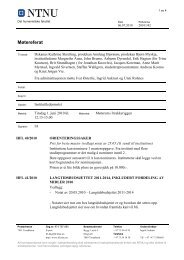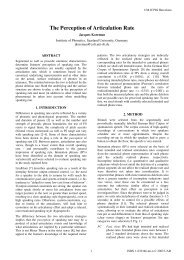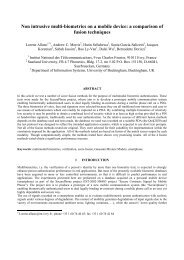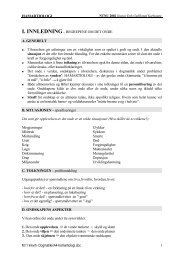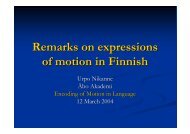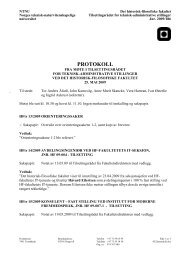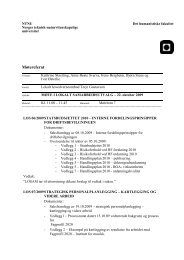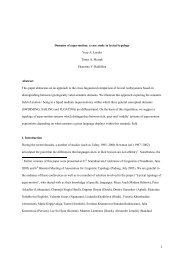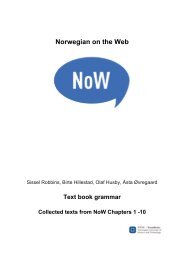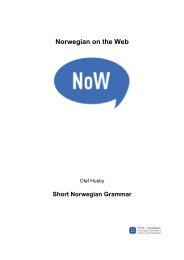In press: In: Dimitrova-Vulchanova, M - NTNU
In press: In: Dimitrova-Vulchanova, M - NTNU
In press: In: Dimitrova-Vulchanova, M - NTNU
Create successful ePaper yourself
Turn your PDF publications into a flip-book with our unique Google optimized e-Paper software.
motion scenes that we had selected for the conceptual representation and lexical encoding of<br />
such scenes. Our experiment has also demonstrated that subjects generally prefer the basiclevel<br />
biological motion verbs to both more general (super-ordinate) and more concrete (underordinate)<br />
verbs. Our general results have shed some light on the issue of universality of<br />
cognitive concepts and their encoding in language. Our data provide support to the view that<br />
many conceptual primitives are indeed based in universal cognitive categories. The main<br />
difference across languages resides in how these features/primitives are encoded (or ‘bundle’<br />
to use Jackendoff’s term) in lexical items and underdetermine their felicitous use. As it turns<br />
out, a possible distinction might be along the lines of how these features split into sufficient<br />
and necessary conditions, and whether these conditions apply in conjunction or disjunction<br />
(cf. a new function proposed by Jackendoff 2002 for the latter type of disjunction).<br />
Apparently, there are robust features that underlie the core concepts (which are also<br />
semantically relevant) confirmed in our study by the overall high confidence level for<br />
canonical (default) scenes across all three languages. Our data also indicate that in naming<br />
processes there appears to be a prototypical packaging of the features that characterize<br />
biological motion (e.g., walking upright front-forwards left-to-right, as also shown in Jellema<br />
et al. 2002), while marginal members of the category are notoriously difficult to name. An<br />
interesting question here is what is more salient in motion identification, the motion pattern<br />
(cycle) or the body-shape/form, or rather the combination of both (cf. Madoley & Smith 2003<br />
for a developmental study). <strong>In</strong> our study, non-default settings of more than one parameter<br />
dramatically influence subjects’ responses or produce what we call “jamming” effects. The<br />
latter were also observed with images showing “nonsensical movements”, such as e.g., a<br />
baby-tortoise struggling to walk on a sand beach. That is, movements that are biologically<br />
possible (e.g. following the laws of gravity, use of limbs etc.), which are, however, rarely<br />
observed or culturally non-salient. 17 <strong>In</strong> such cases the preferred naming strategy is to use a<br />
verb at grain level 0 (underspecified on all parameters) or try out obsolete or rare words.<br />
Satellites would be used in conjunction with level 0 verbs or basic-level biological motion<br />
verbs when more than one parameter is set at a non-default value. This strategy is clearly at<br />
deviance from previously suggested functions of satellites, and we choose to label it the nondefault<br />
explication function. Future cross-linguistic research will provide further support to<br />
this tendency.<br />
17 These images included, among others, a penguin sliding down an ice slope on full body, a baby sea turtle<br />
trying to walk, a chimp baby trying to walk, a fish using its fins to “walk” out of water.<br />
35



